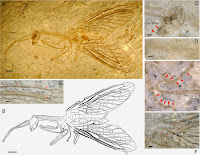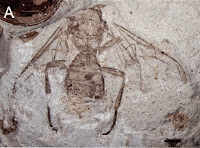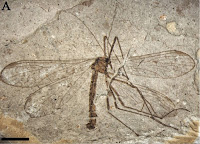Protoplecid Flies are a group of True Flies, Diptera, known from
Jurassic deposits across Eurasia. They are thought to be ancestral to the
modern Bibionidae (March Flies and Love Bugs) and the group is therefore considered paraphyletic
(i.e. not everything descended from the earliest common ancestor of the group
is included in the group). The first Protoplecid specimens were described from Karatau in southern Kazakhstan in 1938, and members of the group have subsequently been described
from Germany, Kyrgyzstan and a number of sites from China. The earliest
specimens known come from the Blue Lias in Germany.
In a paper published in the journal ZooKeys on 30 March 2015,Xiuqin
Lin, Chungkun Shih and Dong Ren of the Key Lab of Insect Evolution and
Environmental Change at Capital Normal University describe five new species of Protoplecid
Flies from the latest Middle Jurassic Jiulongshan Formation of Inner Mongolia
(the ‘Daohugou Biota’). All are placed in the genus Epimesoplecia, which previously contained two species, both
described from the Daohugou Biota in 2007.
The first new species described is named Epimesoplecia plethora, where ‘plethora’
means ‘fullness’ in reference to the dense fur on the body. The species is
described from two specimens, a well preserved female plus a partial fossil of
indeterminate sex. The female is 10 mm in length with crescent shaped compound
eyes, thin and slender forelegs and longer, hindlegs and long, narrow wings.
Epimesoplecia
plethora, female specimen. Scale bar is 1 mm. Lin et al. (2015).
The second new species described is named Epimesoplecia prosoneura, where ‘prosoneura’
means ‘before the sinew’, in reference to the venation of the wings. The
species is described from one male and one female specimens. The male is 9.3 mm
in length, the female 8.2 mm. The male has more protrusive eyes than the
female, both have long antennae with thick bases, becoming more slender towards
the tips, slender fore- and middle legs, with slightly thicker and longer
hindlegs and long, narrow wings.
Epimesoplecia prosoneura, male specimen. Scale bar is 1 mm. Lin et al. (2015).
The third new species described is named Epimesoplecia stana, where ‘stana’
is ‘an arbitrary combination of letters’. The species is described from a
single female specimen. This is 10.2 mm in length with slender forelegs,
intermediate midlegs and thicker hindlegs and long, narrow wings.
Epimesoplecia stana, female specimen. Scale bar is 1 mm. Lin et al. (2015).
The fourth new species described is named Epimesoplecia macrostrena, where ‘macrostrena’ means ‘large and strong’, in reference to the large
wings and apparently strong body of this species. The species is described from
two specimens of indeterminate sex and a female. These are 7-11.3 mm in length
with small heads, thick legs and long, narrow wings.
Epimesoplecia macrostrena, specimen of indeterminate sex. Scale bar is 1 mm. Lin et al. (2015).
The fifth new species is named Epimesoplecia ambloneura,
where ‘ambloneura’ means ‘obtuse
sinew’, in reference to the venation of the wings. The species is described
from one female specimen and one partial specimen of indeterminate sex (in
their description Lin et al. describe
the first specimen as ‘male’, but then go on to describe its anatomy as female,
including illustrations of female genitalia, so ‘male’ is presumably a typing
error). The complete specimen is 12.7 mm long. Both have small oval heads with
long antennae, thick legs and long narrow wings.
Epimesoplecia ambloneura, female specimen. Scale bar is 1 mm. Lin et al. (2015).
See also…
Hangingflies, Bittacidae, are large members of the Scorpionfly
order, Mecoptera, which resemble the more widespread Craneflies (members of the
True Fly order, Diptera) both in morphology and lifestyle, although...
 A new species of Snakefly from the Middle Jurassic of Inner Mongolia. Snakeflies (Raphidioptera) are a group of carnivorous flying insects
related to the Lacewings, Antlions and Alderflies. They have long life
cycles, with a number of larval stages, but still feed as adults. Modern...
A new species of Snakefly from the Middle Jurassic of Inner Mongolia. Snakeflies (Raphidioptera) are a group of carnivorous flying insects
related to the Lacewings, Antlions and Alderflies. They have long life
cycles, with a number of larval stages, but still feed as adults. Modern... Two new species of Helorid Wasps from the Middle Jurasic Jiulongshan Formation of Inner Mongolia. Helorid Wasps are small, black, parasiotoid Wasps, with larvae that
develop inside the bodies of the young of Green Lacewings. The group has
a long fossil...
Two new species of Helorid Wasps from the Middle Jurasic Jiulongshan Formation of Inner Mongolia. Helorid Wasps are small, black, parasiotoid Wasps, with larvae that
develop inside the bodies of the young of Green Lacewings. The group has
a long fossil...
Follow Sciency Thoughts on Facebook.






